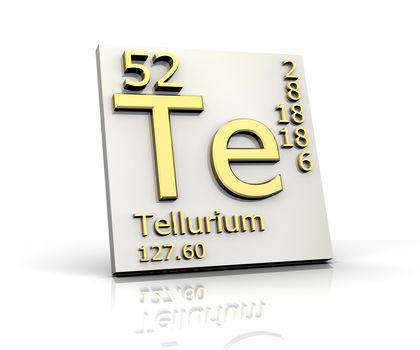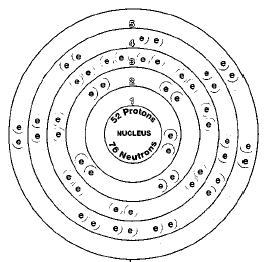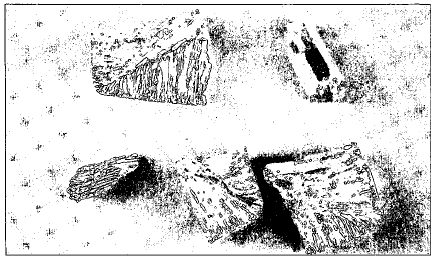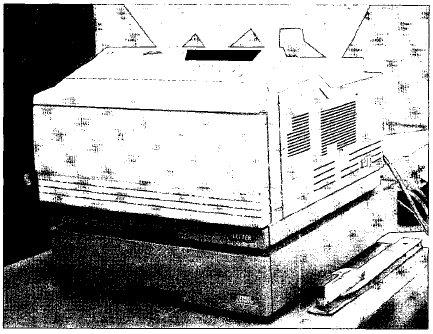TELLURIUM


Overview
The elements that make up Group 16 (VIA) of the periodic table are sometimes called the chalcogens. This name comes from the Greek word for "bronze ore," chalkos. The first two elements in the family, oxygen and sulfur, are often found in such ores. Tellurium is the next to last member of that family. The periodic table is a chart that shows how chemical elements are related to one another.
The chalcogens are one of the most interesting families in the periodic table. The first member, oxygen, is a gas with very unmetal-Like properties. The next two members of the family, sulfur and selenium, are solids, with increasingly metallic properties. Tellurium, near the bottom of the family, looks and behaves very much like most metals. The slow change of properties, from less metal-like to more metal-like, occurs in all families in the periodic table. But the change is seldom as dramatic as it is in the chalcogens.
SYMBOL
Te
ATOMIC NUMBER
52
ATOMIC MASS
127.60
FAMILY
Group 16 (VIA)
Chalcogen
PRONUNCIATION
tuh-LUHR-ee-um
Tellurium was discovered in 1782 by Austrian mineralogist Baron Franz Joseph Muller von Reichenstein (1740-1825 or 1826). The element seldom occurs in its pure state. It is usually found as a compound in ores of gold, silver, copper, lead, mercury, or bismuth. The most common use of tellurium today is in specialized alloys. An alloy is made by melting and mixing two or more metals. The mixture has properties different from those of the individual metals. About three-quarters of all tellurium goes into alloys. The other two major uses of tellurium are in making chemicals and electrical equipment.
Discovery and naming
Muller discovered tellurium while studying gold taken from a mine in the Börzsöny Mountains of Hungary. He had received the gold from a colleague who thought that it contained an impurity. The colleague was unable to identify the impurity, but thought it might be "unripe gold."
The concept of "unripe gold" was invented before the birth of modern chemistry. Earlier scientists—called alchemists—thought that gold "grew" in the earth in much the same way that plants grow. They thought gold went through various stages, from lead to mercury to silver to gold. These metals were thought to be the same material in various stages of growth.
This view of tellurium is reflected in some of its older common names. It was also known as aurum paradoxum and as metallum problematum. The first name means "paradoxical gold," something that acts tike gold, but really isn't. The second name means "the problem metal."
Müller held more modern views, however. He suspected that the impurity was not "unripe gold," but a new element. He conducted more than fifty tests on the new material over a three-year period. He came to have a clear understanding of the new element.
Many years later, Muller sent a sample of the new element to German chemist Martin Heinrich Klaproth (1743-1817). Klaproth confirmed Müller's discovery. He suggested the name tellurium, from the Latin word tellus, meaning "Earth."
Tellurium is often found with another element, selenium. That element was discovered 30 years later and named in honor of the Moon. In Latin, the moon is selene. The connection between tellurium and selenium is more clear now than it was when tellurium was first discovered.

Physical properties
Tellurium is a grayish-white solid with a shiny surface. It has a melting point of 449.8°C (841.6°F) and a boiling point of 989.9°C (1,814°F). Its density is 6.24 grams per cubic centimeter. It is relatively soft. Although it has many metal-like properties, it breaks apart rather easily and does not conduct an electric current very well.
Chemical properties
Tellurium does not dissolve in water. But it does dissolve in most acids and some alkalis. An alkali is a chemical with properties opposite those of an acid. Sodium hydroxide (common lye, such as Drano) and limewater are examples of alkalis.
Tellurium also has the unusual property of combining with gold. Gold normally combines with very few elements. The compound formed between gold and tellurium is called gold telluride (Au 2 Te 3 ). Much of the gold found in the earth occurs in the form of gold telluride.
Occurrence in nature
Tellurium is one of the rarest elements in the Earth's crust. Its abundance is estimated to be about 1 part per billion. That places it about number 75 in abundance of the elements in the earth. It is less common than gold, silver, or platinum.
The most common mineral of tellurium is sylvanite. Sylvanite is a complex combination of gold, silver, and tellurium. Tellurium is obtained commercially today as a by-product in copper and lead refining.
Isotopes
Eight naturally occurring isotopes of tellurium are known. They are tellurium-120, tellurium-122, tellurium-123, tellurium-124, tellurium-125, tellurium-126, tellurium-128, tellurium-130. Isotopes are two or more forms of an element. Isotopes differ from each other according to their mass number. The number written to the right of the element's name is the mass number. The mass number represents the number of protons plus neutrons in the nucleus of an atom of the element. The number of protons determines the element, but the number of neutrons in the atom of any one element can vary. Each variation is an isotope.
At least a dozen radioactive isotopes of tellurium are known also. A radioactive isotope is one that breaks apart and gives off some form of radiation. Radioactive isotopes are produced when very small particles are fired at atoms. These particles stick in the atoms and make them radioactive.
None of the radioactive isotopes of tellurium have any commercial uses.
Extraction
A common method for obtaining tellurium is to pass an electric current
through dissolved tellurium dioxide (TeO
2
). The current breaks the tellurium dioxide down into oxygen and
tellurium:
Tellurium has the unusual property of combining with gold. Gold normally combines with very few elements.
Uses and compounds
About 75 percent of all the tellurium produced today is used in alloys. Its most important alloy is a tellurium-steel alloy. It has better machinability than does steel without tellurium. Machinability means working with a metal: bending, cutting, shaping, turning, and finishing the metal, for example. Adding 0.04 percent tellurium to steel makes it much easier to work with.

Tellurium is also added to copper to improve machinability. Tellurium-copper alloys are also easier to work with than pure copper. And the essential ability of copper to conduct an electric current is not affected. Tellurium is also added to lead. Tellurium-lead alloys are more resistant to vibration and fatigue than pure lead. Metal fatigue is the tendency of a metal to wear out and eventually break down after long use.
About 15 percent of all tellurium produced is used in the rubber and textile industries. It is important in the vulcanization of rubber, for example. Vulcanization is the process by which soft rubber is converted to a harder, longer-lasting product. Tellurium is also used as a catalyst in the manufacture of synthetic fibers. A catalyst is a substance used to speed up or slow down a chemical reaction without undergoing any change itself.
A growing application of tellurium is in a variety of electrical devices. For example, it is used to improve picture quality in photocopiers and printers. A compound of tellurium, cadmium, and mercury is also used in infrared detection systems. Infrared radiation is heat. It can be made visible with special glass. Some satellites orbiting the Earth study forests, crops, and other plant life by measuring the infrared radiation they give off.
Finally, a very small amount of tellurium is used for minor applications, such as a coloring agent in glass and ceramics and in blasting caps for construction projects.
Tellurium gives a garlicky-odor to the breath.
Health effects
When taken internally, tellurium can have harmful effects. It may cause nausea, vomiting, and damage to the central nervous system. One interesting side effect is that it gives a garlicky-odor to the breath.